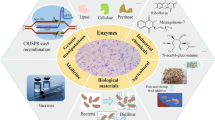Abstract
In order to determine whether the enhanced specific antibody productivity (q MAb ) of calcium alginate-entrapped hybridoma is cell line-specific, calcium alginate-entrapped hybridomas (4A2 and DB9G8) were cultivated under the condition where we had previously observed significantly enhancedq MAb of calcium alginate-entrapped S3H5/γ2bA2 hybridoma. Unlike S3H5/γ2bA2 hybridoma, neither 4A2 nor DB9G8 hybridomas showed persistently enhancedq MAb when they were entrapped in calcium alginate beads. The enhancedq MAb of entrapped 4A2 and DB9G8 hybridomas, which was 2–3 times higher than theq MAb of free-suspended cells in a control experiment, was observed only during the early stage of the culture. During the early stage of the culture, the viable cell concentration decreased probably due to cell damage during the entrapment process. As cell growth resumed, theq MAb decreased to the similar level ofq MAb of free-suspended cells within 5–7 days. Thus, we conclude that the enhancedq MAb of calcium alginate-entrapped hybridomas is cell line-specific.
Similar content being viewed by others
References
De la Broise D, Noiseux M, Massie B and Lemieux R (1992) Hybridoma perfusion systems: A comparison study. Biotechnol. Bioeng. 40: 25–32.
Heath C (1988) Engineering aspects of improved antibody production by hybridomas. Ph.D. thesis. Rensselaer Polytechnic Institute. Troy, NY, USA.
Hiller GW, Aeschlimann AD, Clark DS and Blanch HW (1991) A kinetic analysis of hybridoma growth and metabolism in continuous suspension culture on serum-free medium. Biotech. Bioeng. 38: 733–741.
Hiller GW, Clark DS and Blanch HW (1993) Cell retentionchemostat studies of hybridoma cells-analysis of hybridoma growth and metabolism in continuous suspension culture on serum-free medium. Biotech. Bioeng. 42: 185–195.
Kidwell W (1989) Filtering out inhibition. Bio/Technol 7: 462–463.
Lee GM, Huard TK and Palsson BO (1989) Effect of serum concentration on hybridoma cell growth and monoclonal antibody production at various initial cell densities. Hybridoma 8: 369–375.
Lee GM and Palsson BO (1990) Immobilization can improve the stability of hybridoma antibody productivity in serum-free media. Biotechnol. Bioeng. 36: 1049–1055.
Lee GM, Varma A and Palsson BO (1991a) Production of monoclonal antibody using free-suspended and immobilized hybridoma cells: Effect of serum. Biotechnol. Bioeng. 38: 821–830.
Lee GM, Gray JJ and Palsson BO (1991b) Effect of trisodium citrate treatment on hybridoma cell viability. Biotechnol. Technique 5: 295–298.
Lee GM, Han BK, Kim JH and Palsson BO (1992) Effect of calcium chloride treatment on hybridoma cell viability and growth. Biotechnol. Lett. 14: 891–896.
Lee GM, Chuck AS and Palsson BO (1993) Cell culture conditions determine the enhancement of specific monoclonal antibody productivity of calcium alginate-entrapped S3H5/γ2bA2 hybridoma cells. Biotechnol. Bioeng. 41: 330–340.
Lee GM and Palsson BO (1993a) Stability of antibody productivity is improved when hybridoma cells are entrapped in calcium alginate beads. Biotechnol. Bioeng. 42: 1131–1135.
Lim F (1984) Microencapsulation of living cells and tissues. In: Lim F (ed.) Biomedical Application of Microencapsulation. (pp. 137–154). CRC Press, Boca Raton, FL, USA.
Lim F (1988) Microencapsulation of living mammalian cells. In: Mizrahi A (ed.) Upstream Processes: Equipment and Techniques. (pp. 185–197). Alan R. Liss, New York.
Mancuso A, Fernandez EJ, Blanch HW and Clark DS (1990) A nuclear magnetic resonance technique for determining hybridoma cell concentration in hollow fiber bioreactors. Bio/Technol. 8: 1282–1285.
McKinney KL, Dilwith R and Belfort G (1991) Manipulation of heterogeneous hybridoma cultures for overproduction of monoclonal antibodies. Biotechnol. Prog. 7: 445–454.
Meilhoc E, Witrup KD and Bailey JE (1989) Application of flow cytometric measurement of surface IgG in kinetic analysis of monoclonal antibody synthesis and secretion by murine hybridoma cells. J. Immunol. Methods 121: 167–174.
Miller WM (1987) A kinetic analysis of hybridoma growth and metabolism. Ph.D. thesis, University California, Berkeley, CA, USA.
Passini CA and Goochee CF (1989) Response of a mouse hybridoma cell line to heat shock, agitation, and sparging. Biotechnol. Prog. 5: 175–188.
Ray NG, Vournakis JN, Runstadler PW, Tung AS and Venkatasubramanian K (1990) Physiology of hybridoma and recombinant Chinese Hamster Ovary cells immobilized in collagen matrix, In: de Bont JAM, Visser J, Mattiasson B and Tramper J (eds.), Physiology of Immobilized Cells. (pp. 699–711) Elsevier, Amsterdam.
Reddy S, Bauer KD and Miller WM (1992) Determination of antibody content in live versus dead hybridoma cells: analysis of antibody production in osmotically stressed cultures. Biotechnol. Bioeng. 40: 947–964.
Schroer, JA, Bender T, Feldmann RJ and Kim KJ (1983) Mapping epitopes on the insulin molecule using monoclonal antibodies. Eur. J. Immunol. 13: 693–700
Shen BQ, Reid G and Greenfield PF (1992) Continuous monoclonal antibody production by a composite gel perfusion reactor in a protein-free medium, In: Murakami H, Shirahata S and Tachibana H (eds.), Animal Cell Technology: Basic and Applied Aspects. (pp. 173–178) Kluwer Academic Publishers, Dordecht.
Shirai Y, Hashimoto K, Yamaji H and Tokashiki M (1987) Continuous production of monoclonal antibody with immobilized hybridoma cells in an expanded bed fermentor. Appl. Microbiol. Biotechnol. 26: 495–499.
Sinacore MS, Creswick BC and Buehler R (1989) Entrapment and growth of murine hybridoma cells in calcium alginate gel microbeads. Bio/Technol. 7: 1275–1279.
Wohlpart D, Gainer J and Kirwan D (1991) Oxygen uptake by entrapped hybridoma cells. Biotechnol. Bioeng. 37: 1050–1053.
Author information
Authors and Affiliations
Rights and permissions
About this article
Cite this article
Lee, G.M., Kim, S.J. & Palsson, B.O. Enhanced specific antibody productivity of calcium alginate-entrapped hybridoma is cell line-specific. Cytotechnology 16, 1–15 (1994). https://doi.org/10.1007/BF00761774
Received:
Accepted:
Issue Date:
DOI: https://doi.org/10.1007/BF00761774




